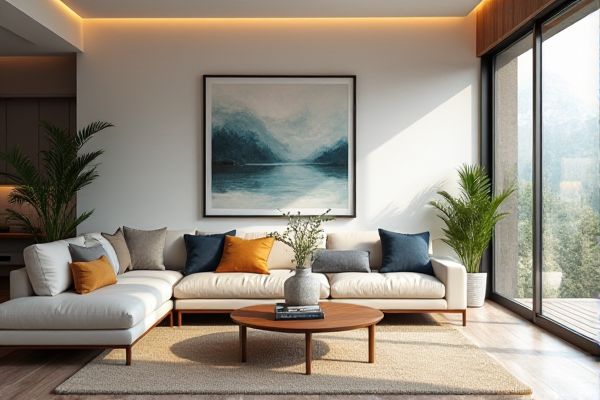
Abstract art emphasizes shapes, colors, and forms to evoke emotions without representing reality, while landscape art captures natural scenes with detailed and realistic depictions. Explore this article to understand how these two art styles contrast and what makes each unique for your artistic appreciation.
Table of Comparison
| Aspect | Abstract Art | Landscape Art |
|---|---|---|
| Definition | Art that uses shapes, colors, and forms without representing real objects | Art depicting natural scenery like mountains, forests, and rivers |
| Focus | Emotions, concepts, and visual effects | Realistic or idealized portrayal of the natural environment |
| Style | Non-representational, often experimental | Representational, detailed, and naturalistic |
| Techniques | Bold colors, geometric shapes, and dynamic brushstrokes | Perspective, light, shadow, and natural colors |
| Notable Artists | Wassily Kandinsky, Jackson Pollock, Piet Mondrian | Claude Monet, Thomas Cole, John Constable |
| Purpose | Express abstract ideas and provoke thought | Capture and celebrate natural beauty |
Introduction to Abstract and Landscape Art
Abstract art emphasizes shapes, colors, and forms independent of real-world objects, creating emotional or conceptual experiences. Landscape art captures natural scenery with detailed representation, often highlighting elements like mountains, rivers, and forests. Understanding these distinct approaches helps you appreciate their unique visual narratives and artistic intentions.
Defining Characteristics of Abstract Art
Abstract art emphasizes shapes, colors, and forms without representing real-world objects, focusing on emotional expression and conceptual ideas. It often uses non-representational elements, such as geometric patterns, bold color contrasts, and spontaneous brushstrokes to evoke subjective interpretation. This contrasts with landscape art, which prioritizes realistic depictions of natural scenes, preserving perspective, depth, and recognizable environmental features.
Key Elements of Landscape Art
Landscape art centers on the depiction of natural scenery, emphasizing elements such as mountains, trees, water, and atmospheric conditions to evoke a sense of place. Key elements include composition, light and shadow, color harmony, and perspective, which work together to create depth and realism. Your appreciation of landscape art can deepen through understanding how artists capture the dynamic interplay between landforms and weather to convey mood and time.
Historical Origins and Evolution
Abstract art emerged in the early 20th century as artists like Wassily Kandinsky and Piet Mondrian broke away from traditional representational forms to emphasize color, shape, and emotion. Landscape art, with roots tracing back to ancient civilizations and flourishing during the Renaissance and Romantic periods, focuses on realistic depictions of natural scenery. Your appreciation of these art forms can deepen by understanding how landscape art evolved from realistic portrayals to abstract interpretations, reflecting broader shifts in cultural and artistic perspectives.
Techniques and Mediums Used
Abstract art employs diverse techniques such as gestural brushstrokes, color fields, and collage, utilizing mediums like acrylics, oils, mixed media, and digital tools to emphasize form and emotion over realism. Landscape art traditionally relies on techniques like plein air painting, fine detail, and perspective, with mediums including oils, watercolors, and pastels to capture natural scenery accurately. Both styles explore texture and color, but abstract art prioritizes experimental application, whereas landscape art focuses on representation and spatial depth.
Interpretation and Emotional Impact
Abstract art invites Your personal interpretation by emphasizing color, shape, and form without depicting recognizable objects, often evoking complex emotions open to individual perception. Landscape art grounds emotional impact in the realistic portrayal of nature, eliciting feelings of tranquility, awe, or nostalgia through detailed scenes. Both styles engage viewers differently: abstract art challenges You to find meaning internally, while landscape art connects You to the external world's beauty.
Notable Artists and Iconic Works
Abstract art is defined by pioneers like Wassily Kandinsky with his piece "Composition VII" and Jackson Pollock known for "No. 5, 1948," emphasizing emotion through non-representational forms. Landscape art features masters such as Claude Monet, famous for the "Water Lilies" series, and Thomas Cole, renowned for "The Oxbow," capturing natural scenery with detailed realism. Understanding the distinctions between these iconic works can enrich your appreciation of diverse artistic styles.
Popularity and Audience Perception
Abstract art appeals to audiences seeking emotional expression and interpretive freedom, often attracting modern art enthusiasts and younger demographics. Landscape art remains popular among traditional collectors and nature lovers who appreciate realistic representations and scenic beauty. Both genres maintain strong followings, with abstract art dominating contemporary galleries and landscapes excelling in classic and regional art markets.
Contemporary Trends in Both Styles
Contemporary abstract art explores bold color fields, mixed media textures, and non-representational forms to evoke emotion and conceptual depth. Landscape art increasingly integrates urban and environmental themes, utilizing digital techniques and hyperrealism to capture the changing relationship between humans and nature. Both styles embrace experimentation with technology, pushing traditional boundaries to redefine artistic expression in the 21st century.
Choosing Between Abstract and Landscape Art
Choosing between abstract and landscape art depends on your personal taste and the ambiance you want to create in your space. Abstract art offers dynamic expressions, bold colors, and emotional depth, while landscape art provides tranquility, natural beauty, and realistic scenes. Your decision should reflect whether you prefer the imaginative freedom of abstraction or the serene connection to nature that landscapes provide.
 homyna.com
homyna.com